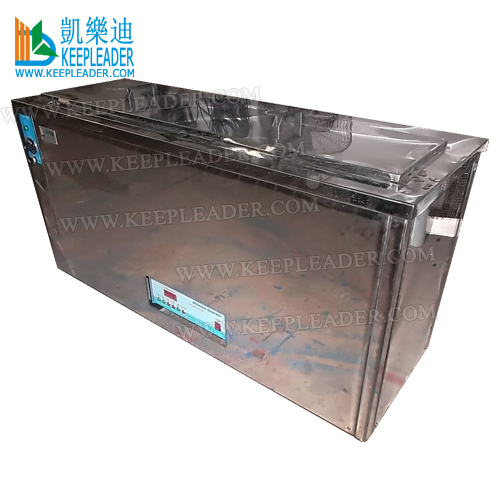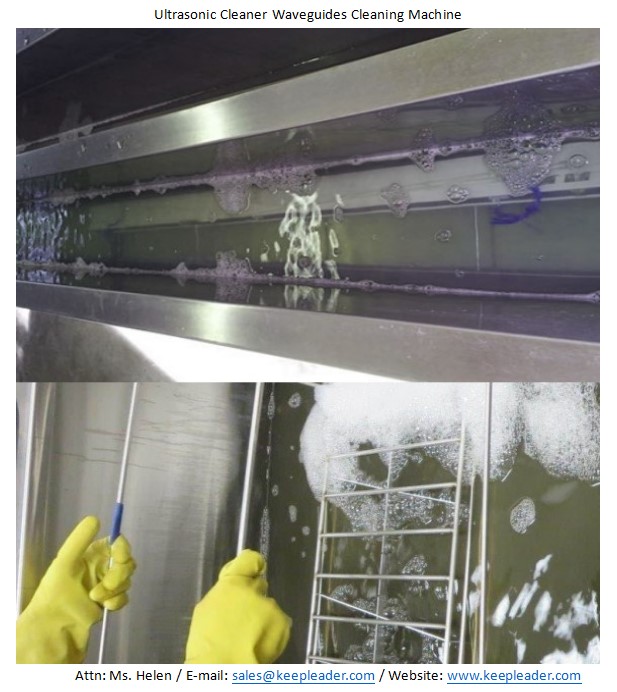Ultrasonic Cleaner Waveguides Cleaning Machine for Waveguide assemblies_Components_Tubes Washing Ultrasound Washer
Ultrasonic Cleaner Waveguides Cleaning Machine
Ultrasonic Cleaner Waveguides Cleaning Machine classifies industrial ultrasonic cleaner for washing Waveguides in removing clogged particles, debris, dust, at small or medium scale, the ultrasonic system use transducer to convert electrical energy into sound waves, which in turn, creates cavitation (voids) bubbles that scrub the Waveguides, the bubbles form and collapse rapidly along the surface and also penetrates small crevices and recesses, as the bubbles implode, they peel off stubborn contamination away from the surface and deep passageway of Waveguides and up to the top of the solution, this implosions disrupt the integrity of the contaminants to be removed, Ultrasonic Cleaner Waveguides Cleaning Machine is out of line-of-sight becomes the popular way of cleaning, especially when it comes to complex Waveguides, and other sensitive electronic parts, not only does it reduces the overall time and money spent on cleaning engine, but also it helps to delivery the best remarkable and reliable results that have never been attained with any other cleaning agents
Product description
Mainly application of Ultrasonic Cleaner Waveguides Cleaning Machine | |
Ultrasonic Cleaner Waveguides Cleaning Machine applied for ultrasonic cleaning of waveguides,Semiconductor wafer, optical glass, clocks, beads,auto parts, engine parts | |
Related field of ultrasonic cleaning technology | |
With cavitations effect Ultrasonic cleaning technology is widely used in ultrasonic golf club cleaning, semi-conductor silicon chip cleaning, optical glass cleaning, parts of watch and cock cleaning, jewelry cleaning, polyester filtration core cleaning, widow blind cleaning and etc | |
Character | |
All imported stainless steel structure, thickening Stainless steel plate, adopting high Q value transducer and German binding process large power of ultrasonic output, set solvent heating and temperature automatic thermostat instrument, and temperature control range 0~100°C, base solvent, no pollution Ultrasonic generator: VT model ultrasonic generator, output power continuously adjustable Range: semi-conductor silicon chip, optical glass, parts of watch and clock, glasses, Jewelry, polyester filtration core and etc | |
Model | KLE-1042 |
frequency | 40KHZ/28KHZ |
Inter-size (mm) | 1400*300*400mm(customized is ok) |
The material of machine | Stainless steel 304 (outset cleaning tank) |
Stainless steel 312(inside cleaning tank) | |
Ultrasonic power | 1.8KW |
Heating power | 6KW |
Control | Digital control |
Cooling method | Fan cooling |
Heating time range | From 0s to 999s |
Temperature range | 0 to 100 degree |
Counter | Digital display |
Working mode | self-excitation |
Vibrator assembled mode | Bottom or side |
Loading method | Manual(robot arm is optional) |
pls contact KEEPLEADER for more info and teck assistance upon Ultrasonic Cleaner Waveguides Cleaning Machine
Product uses
Ultrasonic Cleaner Waveguides Cleaning Machine performs consistent cleaning process in reliable effects of removing stubborn dirty clogged inside of passageway,crevices,cracks, recesses, bind holes and corners of Waveguides, professional schedules in cleaning arrangement can yield twice the results with half the effort, in addition, timely maintenance can improve the longevity
Ultrasonic cleaning procedure: to ensure effective cleaning, if may require that you follow some good cleaning procedures, there are some steps you can follow, but skipping certain step or not depends on the nature of how dirty or contaminated they are, generally, ultrasonic cleaning procedures are, 1st step: pre-rinsing, this step is followed in a situation, where there are great number of contaminants to remove, lukewarm water is used to remove a large amount of debris and contaminants from Waveguides 2nd,put the Waveguides in the ultrasonic tank, this is step that no Waveguides can skip, after pre-rinsing your Waveguides, put them inside the tank, this should be done in an orderly manner, you can make use of basket, or holding frame instead of putting the Waveguides inside the tank directly, 3rd, after ultrasonic agitation cleaning, the final step is precision rinsing process or drying process prior to ready installation
The fundamental maintenance for Ultrasonic Cleaner Waveguides Cleaning Machine: now days,our ultrasonic cleaning machines have one year warranty, which can be voided if users do not meet certain conditions, here are some maintenance tips that can help you use the ultrasonic cleaner for a lifetime,1st: don’t operate it when the solution is too low, it can damage the transducers and heating elements, 2nd: don”t allow Waveguides to touch the bottom of the tank it can scratch or etch the spectrum,3rd: don’t use solution with a high alkaline or acid level,4th: ensure the ultrasonic generator and transducers and control panel are clean and dry, moisture inside of electronic cabinet often the elementary reasons of malfunction,5th: ensuring the proper maintenance of ultrasonic cleaning machine can assist you getting the best performance possible
FRQ
What are ultrasonic waves of ultrasonic cleaning?
Ultrasonic waves are sound waves transmitted above 20khz, or higher that the frequency detectable by humans, sounds waves are created by the vibration of an object, which causes the air molecules around it to vibrate, these vibrations cause our eardrums to vibrate, which the brains then interprets as sound when the original vibration is very fast, so the sound waves, and the pitch of the sound created is too high for the human ear to hear
In the natural world, animals like dolphins and bats are use these ultrasonic waves to communicate, but humans have discovered practical application, the most commonly known is medical ultrasonography although in the last 30 years, some organizations have discovered highly effective, chemical-free cleaning applications and technology, ultrasonic cleaning machines work in a vey similar way to a loud speaker, except the ultrasonic waves travel at a much higher frequency and through water instead of air, a high-frequency electronic generator that creates ultrasonic waves is connected to a diaphragm, a flat or cone-shaped structure similar to the visible cone-shaped portion of a loudspeaker, that generator vibrates the diaphragm at a specific high frequency, usually between 25 and 170khz, inside a specially designed water tank, the ultrasonic waves created cause the water molecules to vibrate rapidly, creating alternating waves of compression and expansion within the water, during the expansion phase, or rarefaction cycle, the liquid is torn apart, creating cavitations bubbles, these bubbles are where ultrasonic cleaning technology is born
How does ultrasonic cleaning machine work?
Cavitations bubbles are vacuum cavities as tiny as red blood cell, or about 8 thousands of a millimeter across, they are so small that it would take 1250 of them lined up in a row to reach 1cm long
Under pressure of continuous vibration, these bubbles stretch and compress at a fast rate, once they reach a certain size, as determined by the frequency and stretch of the sound waves produces, the bubbles lose structural integrity and collapse violently, when these implosions happen near a surface, the bubbles emit high-powered steams of plasma that travel at more that 500 miles per hours and collide with, agitate and remove even very tiny particles and substances from that surface
In an ultrasonic cleaning machine, this happens millions of times per second, but because cavitations bubbles are so small, the process is both highly effective and very gentle, ultrasonic technology can be clean metals, plastics, glass, rubber and ceramics, it effectively removes a wide variety of contaminants, even if present only in trace amounts, including dust, dirty, rust, oil, grease, soot, mold, carbon deposits, polishing compounds, was, pigments, lime scale, bacteria, algae, fungus, fingerprints and biological soil
These contaminants typically are removed even if they are tightly adhered to or embedded onto solid surfaces, or if they are in remote cracks or tiny crevices of an object. For this reason, items usually do not need to be disassembled before being put safely in an ultrasonic cleaning unit
Cleaning solution?
As ultrasonic cleaning technology was developed, it was discovered that if surface tension is reduced, cavitations levels increase, cleaning solutions used with ultrasonic cleaning machines
Contain ingredients specially designed to increase the effectiveness of the process. These are called surfactants and they lower the surface tension of water.
General-use soap solutions: these solutions have a high alkaline content and are designed to remove a number of contaminants from metals, plastics and fabrics, depending on their formulation, soap-based metal cleaners will remove oil, grease, and carbon deposits, those formulated for use with plastic and fabric items won’t clean oil-based deposit from these materials
Descaling detergents: are formulated to clean metals laden with corrosion, rust, hard mineral deposits or heat scale. They are designed to help restore parts that have been in service in hard water or high-humidity environments. These solutions are acidic in nature.
Enzyme detergents: Enzymes are used to degrease stainless steel, aluminum, brass and titanium parts, and ca be more effective that general-use soaps when removing oil and grease, they are designed to clean heavily oiled surfaces when an oil-free environment is preferred or required, they also can be used effectively to remove biological contaminants from medical, surgical, dental, and optical tools, enzymes typically consume oil residue and digest it off as carbon dioxide
How Ph cleaners: come in number of formulations and can be helpful in several ultrasonic cleaning application, and protect metals from the effects of chemicals, some of the stronger how pH cleaners many damage certain materials, specifically aluminum, copper, and brass, citric acid solutions are used to passivate stainless steel and titanium by removing the free iron molecules from the surface of the metal to help prevent future corrosion such as rust
Specialty detergents: some solutions are formulated to clean specific contaminations like smoke, soot and certain odors, although these specialty detergents will work very effectively when used in certain application, they can be harmful or ineffective when used outside of their intended use
Some solutions are formulated to clean specific contaminants like smoke, soot and certain odors. Although these specialty detergents will work very effectively when used in certain application, they can be harmful or ineffective when used outside of their intended use.
What should consider on longevity?
Some solutions have a longer lifespan that others, which helps decrease long-term cost, but all solutions have their pros and cons, for example, when removing oil and coolants, users must choose between using an emulsifier solution or separating detergent, and emulsifier holds oil in suspension with in fluid, so it does not last as long, once the solution is saturated with oil, it is no longer effective, a separator can remain effective for up to three months or longer, however, it cleans less effectively and, since oil rises to the surface of the tank, users risk recontaminations during item removal unless filtration systems-overflow weirs or surface spargers-are added to the unit
What should consider on solution disposal?
Most ultrasonic cleaning baths are environmentally friendly and water-based, but depending on the solution used and contaminant removed, various methods of waste disposal may be required, most ultrasonic cleaning baths are 92 percent water and wastewater evaporators will reduce the amount of material required disposal by that amount, these solutions also often can be effectively neutralized or filtered until it can be released into the sewer system safely and legally
Is heating should be considered in solution cleaning?
Solution are often used in combination with heat, which effectively eliminate entrapped air in the water tank, for most applications, a temperature of 50 to 65 degree is effective, however, for some medical applications it is generally accepted that solutions should be used at temperature below 38 degree to prevent protein coagulation
Contact Us
Ultrasonic Cleaner Waveguides Cleaning Machine is the most efficient recipe to remove contaminants from waveguides, and other electronic components, in comparison with standard 40khz ultrasonic cleaners, our waveguides ultrasonic cleaner delivers 28khz powerful cavitation, which allow great cleaning results in heavy duty applications as stubborn dirty removal, our ultrasonic cleaning machine range is designed for all waveguides sizes and types, in order to choose right tank size at least, 100~150mm free space needs to left between the waveguides and tank wall, share with keepleader the size of the waveguides to be cleaned and number of waveguides to clean every 8 hour shift and, keepleader, we will prepare a proposal for you, don’t hesitate to contact us
Products
Search
ContactUs
ADD: Rongxing Bldg, Bulong rd, Bantian st, Longgang, Shenzhen 518129 P.R.China
ZIP: 518129
Contact: Ms Wang
Tel: +86-755-84190358
Fax: +86-755-84190358
Mob: +86-13590415784
Email: sales@keepleader.com

Welcome to visit our Factory!!!
Copyright ©2004-2026 ultrasonic cleaner,ultrasonic welder,high frequency welder,Ultrasonic golf Cleaner,High frequency packing machine,Vapor degreaser,Transparent Cylinder making machine,portable spot welders All Rights Reserved.
ADD: Rongxing Bldg, Bulong rd, Bantian st, Longgang, Shenzhen 518129 P.R.China ZIP: 518129 Contact: Ms Wang
Tel: +86-755-84190358 Fax: +86-755-84190358 Mob: +86-13590415784
Email: sales@keepleader.com 技术支持: keepleader




